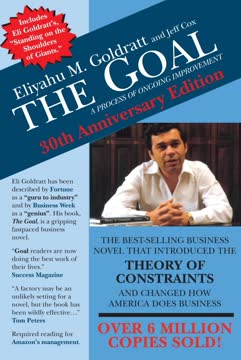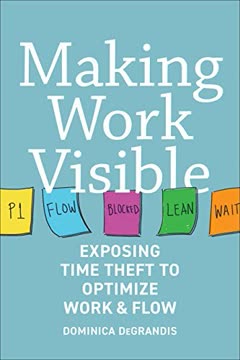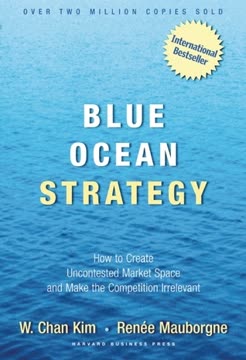نکات کلیدی
1. تفکر سیستمی برای مدیریت مؤثر و حل مسئله حیاتی است
دمینگ بر این باور بود که بهبود واقعی کیفیت بدون دانش عمیق ممکن نیست.
نگاه سیستمی. تفکر سیستمی شامل دیدن سازمانها بهعنوان شبکههای مرتبط بهجای اجزای جداگانه است. این رویکرد به این نکته اشاره دارد که عملکرد یک سیستم تنها مجموع اجزای آن نیست، بلکه نتیجه تعاملات پیچیده بین اجزا است. مدیرانی که تفکر سیستمی را در پیش میگیرند، بهتر میتوانند:
- علل ریشهای مشکلات را شناسایی کنند
- عواقب ناخواسته اقدامات را پیشبینی کنند
- درک کنند که تغییرات در یک حوزه چگونه بر کل سازمان تأثیر میگذارد
با پذیرش تفکر سیستمی، رهبران میتوانند تصمیمات آگاهانهتری اتخاذ کرده و راهحلهای مؤثرتری برای چالشهای سازمانی پیادهسازی کنند.
2. هر سیستم دارای یک محدودیت است که عملکرد آن را محدود میکند
بیایید فرض کنیم که شما بهطور مداوم نیرویی که به این زنجیر وارد میکنید را افزایش میدهید. آیا میتوانید این کار را بهطور نامحدود انجام دهید؟ البته که نه. اگر این کار را ادامه دهید، در نهایت زنجیر خواهد شکست. اما کجا خواهد شکست—در چه نقطهای؟ زنجیر در ضعیفترین حلقهاش خواهد شکست.
شناسایی گلوگاه. در هر سیستم، همیشه یک عامل وجود دارد که عملکرد کلی را محدود میکند. این محدودیت، که اغلب بهعنوان "ضعیفترین حلقه" شناخته میشود، حداکثر خروجی کل سیستم را تعیین میکند. نکات کلیدی در مورد محدودیتها:
- تنها یک محدودیت واقعی در هر زمان وجود دارد
- بهبود در مناطق غیرمحدود نمیتواند تأثیر قابل توجهی بر عملکرد سیستم داشته باشد
- محدودیتها میتوانند فیزیکی (مانند ظرفیت تجهیزات) یا مبتنی بر سیاست (مانند قوانین کاری) باشند
مدیران باید تلاشهای بهبود خود را بر شناسایی و رفع محدودیت فعلی سیستم متمرکز کنند تا بیشترین تأثیر را بر عملکرد کلی داشته باشند.
3. نظریه محدودیتها (TOC) چارچوبی برای بهبود مستمر ارائه میدهد
TOC یک نظریه تجویزی است، به این معنی که نه تنها به شما میگوید چه چیزی سیستم شما را عقب نگه میدارد، بلکه همچنین به شما میگوید چه کار باید انجام دهید و چگونه این کار را انجام دهید.
بهبود سیستماتیک. نظریه محدودیتها یک رویکرد ساختاریافته برای بهبود مستمر سیستم ارائه میدهد. اصول کلیدی TOC شامل:
- تمرکز تلاشهای بهبود بر روی محدودیت سیستم
- درک این نکته که بهینههای محلی لزوماً به بهینههای جهانی منجر نمیشوند
- شناسایی این نکته که راهحلها با گذشت زمان و تغییر شرایط کاهش مییابند
با بهکارگیری اصول TOC، سازمانها میتوانند به بهبودهای سریع دست یابند و چرخهای از بهبود مستمر را حفظ کنند که به شرایط متغیر و محدودیتهای در حال تحول سازگار میشود.
4. پنج مرحله تمرکز راهنمای مدیریت محدودیتها هستند
این آغاز بخش تجویزی نظریه محدودیتها است. گلدرت پنج مرحله متوالی را برای متمرکز کردن تلاشهای بهبود بر روی مؤلفهای که قادر به تولید بیشترین تأثیر مثبت بر سیستم است، توسعه داد.
فرآیند بهبود سیستماتیک. پنج مرحله تمرکز یک نقشهراه واضح برای مدیریت محدودیتها و بهبود عملکرد سیستم ارائه میدهد:
- شناسایی محدودیت
- بهرهبرداری از محدودیت (حداکثر کردن کارایی آن)
- subordinating everything else to the constraint
- ارتقاء محدودیت (در صورت لزوم)
- بازگشت به مرحله 1، اما مراقب موانع باشید
این فرآیند تکراری اطمینان میدهد که تلاشهای بهبود همیشه به سمت تأثیرگذارترین مناطق سیستم هدایت میشود و منجر به افزایش مستمر عملکرد میشود.
5. تولید، موجودی و هزینههای عملیاتی معیارهای کلیدی عملکرد هستند
گلدرت یک رابطه ساده برای تعیین تأثیر هر اقدام محلی بر پیشرفت به سمت هدف سیستم تصور کرد. هر اقدام بر اساس تأثیر آن بر سه بعد سطح سیستم ارزیابی میشود: تولید، موجودی و هزینههای عملیاتی.
اندازهگیری آنچه مهم است. این سه معیار نمای کلی از عملکرد سیستم را ارائه میدهند:
- تولید (T): نرخ تولید پول توسط سیستم از طریق فروش
- موجودی (I): پولی که در سیستم قفل شده است
- هزینههای عملیاتی (OE): پولی که برای تبدیل موجودی به تولید صرف میشود
مدیران باید اقداماتی را که تولید را افزایش میدهند در اولویت قرار دهند و در عین حال بر کاهش موجودی و هزینههای عملیاتی تمرکز ثانویه داشته باشند. این رویکرد اطمینان میدهد که تلاشهای بهبود با هدف نهایی تولید پول بیشتر برای سازمان همراستا باشد.
6. محدودیتهای سیاستی اغلب تأثیر بیشتری نسبت به محدودیتهای فیزیکی دارند
بیشتر محدودیتهایی که در سیستمهای خود با آنها مواجه هستیم، از سیاستها ناشی میشوند—چگونه بهطور عمدی انتخاب میکنیم که عمل کنیم—نه از چیزهای فیزیکی.
چالش فرضیات. محدودیتهای سیاستی، مانند قوانین، رویهها یا ذهنیتهای قدیمی، میتوانند محدودکنندهتر از محدودیتهای فیزیکی مانند ظرفیت تجهیزات باشند. نکات کلیدی:
- محدودیتهای سیاستی اغلب شناسایی آنها دشوارتر از محدودیتهای فیزیکی است
- تغییر سیاستها میتواند به بهبودهای قابل توجهی در سیستم منجر شود
- بهطور منظم سیاستها و رویههای موجود را مرور و مورد سؤال قرار دهید
با جستجوی فعالانه و پرداختن به محدودیتهای سیاستی، سازمانها میتوانند به بهبودهای عملکردی قابل توجهی دست یابند بدون اینکه لزوماً نیاز به سرمایهگذاریهای کلان داشته باشند.
7. ابزارهای فرآیند تفکر منطقی امکان حل مسئله سیستماتیک را فراهم میکنند
گلدرت رویکردی برای بهبود مستمر به نام نظریه محدودیتها توسعه داد. او حتی کتابی در مورد این نظریه نوشت که "هدف" نام دارد.
تحلیل ساختاریافته. فرآیند تفکر منطقی مجموعهای از ابزارها را برای تحلیل و حل سیستماتیک مشکلات پیچیده فراهم میکند:
- درخت واقعیت کنونی: شناسایی علل ریشهای مشکلات موجود
- درخت واقعیت آینده: توسعه و آزمایش راهحلهای بالقوه
- درخت پیشنیاز: برنامهریزی برای پیادهسازی راهحلها
- درخت انتقال: جزئیات برنامههای اجرایی مرحله به مرحله
این ابزارها به مدیران اجازه میدهند تا بهطور منطقی و سیستماتیک از شناسایی مشکل تا پیادهسازی راهحلها پیش بروند و اطمینان حاصل کنند که رویکردی جامع و منطقی برای بهبود دارند.
8. مدیریت تغییر برای پیادهسازی موفق راهحلها ضروری است
با این حال، برخی برآوردها از میزان شکست به 80 درصد میرسد. دلیلی وجود دارد که بسیاری از تغییرات سیستماتیک بزرگ نتوانند انتظارات را بهطور کامل برآورده کنند یا بهطور کامل شکست بخورند.
پرداختن به عوامل انسانی. راهحلهای فنی به تنهایی برای تغییر سازمانی موفق کافی نیستند. جنبههای کلیدی مدیریت تغییر مؤثر شامل:
- ارتباط نیاز به تغییر و مزایای مورد انتظار
- پرداختن به مقاومت و نگرانیهای ذینفعان
- ارائه آموزش و حمایتهای لازم
- تقویت رفتارهای مطلوب و جشن گرفتن موفقیتها
با ادغام اصول مدیریت تغییر با جنبههای فنی حل مسئله، سازمانها میتوانند بهطور قابل توجهی احتمال موفقیت در پیادهسازی و بهبود پایدار را افزایش دهند.
آخرین بهروزرسانی::
FAQ
What's "The Logical Thinking Process: A Systems Approach to Complex Problem Solving" about?
- Systems Approach: The book provides a comprehensive guide to using logical thinking processes to solve complex problems within systems.
- Evolution of Thinking: It builds on the Theory of Constraints by Eliyahu M. Goldratt, advancing the thinking process to a more refined level.
- Logical Tools: It introduces a set of logical tools, including various types of trees and diagrams, to analyze and improve systems.
- Practical Application: The book is designed to help leaders and managers apply these tools to real-life issues effectively.
Why should I read "The Logical Thinking Process"?
- Improved Problem Solving: It offers a structured approach to identifying and solving complex problems in any system.
- Logical Framework: The book provides a logical framework that can be applied across various industries and disciplines.
- Enhanced Decision-Making: By using the tools and methods described, readers can make more informed and effective decisions.
- Comprehensive Guide: It serves as both a learning resource and a reference guide for continuous improvement efforts.
What are the key takeaways of "The Logical Thinking Process"?
- Identify Constraints: Learn to identify the weakest link in a system that limits its performance.
- Logical Tools: Master the use of logical tools like the Current Reality Tree and the Future Reality Tree for system analysis.
- Conflict Resolution: Understand how to resolve conflicts that prevent problem-solving using the Evaporating Cloud method.
- Implementation Strategies: Gain insights into implementing changes effectively with the Prerequisite Tree and Transition Tree.
How does the book build on Goldratt's Theory of Constraints?
- Logical Extension: It extends Goldratt's Theory of Constraints by providing a more detailed logical thinking process.
- Focus on Logic: The book emphasizes the use of deductive logic to improve system performance.
- Practical Tools: It introduces practical tools that were not fully developed in Goldratt's original work.
- Broader Applicability: The methods are applicable to a wider range of systems beyond manufacturing, including strategic planning and policy analysis.
What is the Intermediate Objectives Map in "The Logical Thinking Process"?
- Goal Setting: It helps define the system's goal, critical success factors, and necessary conditions.
- Hierarchy Structure: The map structures these elements in a hierarchical tree to represent the desired state of the system.
- Benchmarking Tool: It serves as a benchmark to measure the gap between current reality and desired outcomes.
- First Step: It is the first step in the logical thinking process, setting the stage for further analysis.
How does the Current Reality Tree function in the book?
- Gap Analysis: It is used to analyze the gap between the current state and the desired state of a system.
- Identify Root Causes: The tree helps trace undesirable effects back to their critical root causes.
- Logical Structure: It provides a logical structure to understand why the current situation differs from the desired one.
- Focus on Change: The tree identifies what needs to change to improve system performance.
What is the Evaporating Cloud method?
- Conflict Resolution: It is a tool designed to resolve hidden conflicts that perpetuate chronic problems.
- Assumption Challenge: The method involves challenging and invalidating assumptions underlying conflicts.
- Creative Solutions: It serves as an idea generator for creating breakthrough solutions.
- Part of the Process: The Evaporating Cloud is integrated into the logical thinking process to address what to change to.
How does the Future Reality Tree validate solutions?
- Logical Testing: It allows for logical testing of proposed solutions before implementation.
- Identify Consequences: The tree helps identify any unfavorable consequences of a proposed action.
- Verification Tool: It verifies that the proposed action will achieve the desired results.
- Strategic Planning: The Future Reality Tree can also be used as a strategic planning tool.
What role does the Prerequisite Tree play in implementation?
- Sequence Planning: It helps plan the sequence of activities needed to implement a decision.
- Obstacle Identification: The tree identifies potential obstacles and suggests ways to overcome them.
- Execution Framework: It provides a framework for executing changes effectively.
- Part of Change Process: The Prerequisite Tree is part of the process to answer how to cause the change.
How does the book address the psychology of change?
- Human Element: It emphasizes the importance of considering the human element in change management.
- Behavioral Insights: The book provides insights into human behavior and resistance to change.
- Change Management: It introduces a model for handling the psychology of change effectively.
- Leadership Role: The book highlights the role of leadership in facilitating successful change.
What are some of the best quotes from "The Logical Thinking Process" and what do they mean?
- "Systems as Chains": This quote emphasizes the idea that systems are like chains, with a weakest link that limits performance.
- "Ideas Are Not Solutions": It highlights the importance of implementation, as ideas alone do not lead to change.
- "Inertia is the Worst Enemy": This quote warns against complacency and the need for continuous improvement.
- "The System Optimum is Not the Sum of the Local Optima": It underscores the importance of focusing on the system as a whole rather than individual components.
How can "The Logical Thinking Process" be applied in real-world scenarios?
- Business Strategy: The methods can be used to develop and implement effective business strategies.
- Problem Solving: It provides a structured approach to solving complex problems in various industries.
- Continuous Improvement: The book's tools can be integrated into continuous improvement efforts for better results.
- Policy Analysis: It offers a systems-level approach to analyzing and improving policies and procedures.
نقد و بررسی
کتاب فرایند تفکر منطقی به خاطر پوشش جامع ابزارهای تئوری محدودیتها و تکنیکهای استدلال منطقی مورد تحسین قرار گرفته است. خوانندگان از دسترسی آسان، رویکرد عملی و توضیحات دقیق همراه با مثالها قدردانی میکنند. این کتاب به خاطر اطلاعات متمرکز و بینشهایش ارزشمند است، هرچند برخی آن را در مواقعی خشک میدانند. این اثر به عنوان منبعی ضروری برای درک فرایند تفکر گلدرت و بهبود سیستمها شناخته میشود. در حالی که برخی از خوانندگان به محدودیتهایی در زمینههای خاص اشاره میکنند، اکثر آنها آن را منبعی عالی برای حل مسائل و تغییرات سازمانی میدانند.
Similar Books














